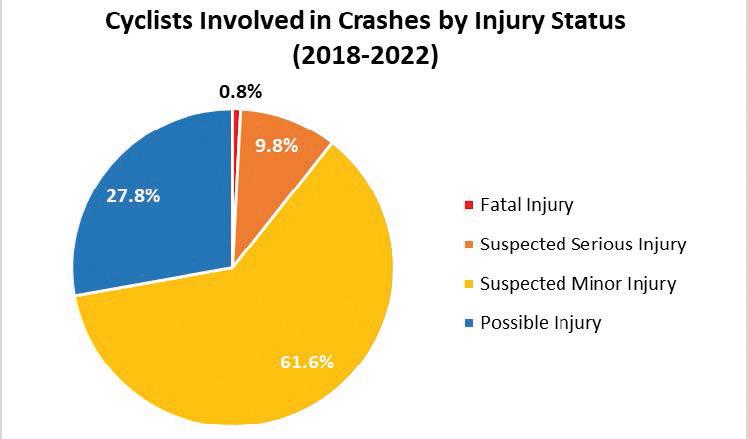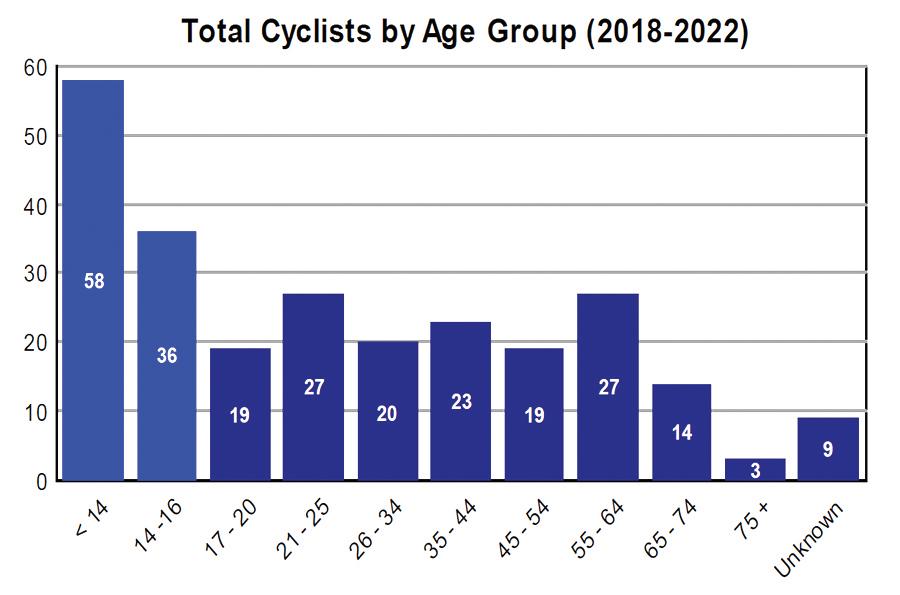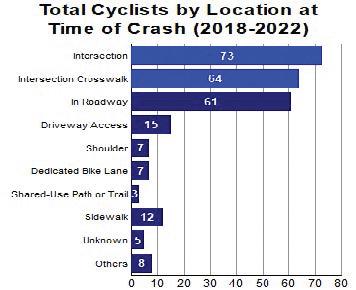
2 minute read
Highway Safety
by WYDOT
Cyclist-Involved Crashes
By Kari Fictum, Highway Safety
Cycling is a popular means of travel for Wyoming residents and visitors alike. People commonly bike to work or school, to access commercial districts for retail shopping or food, and for recreation or exercise. Cycling is a low impact, healthy activity that should be encouraged and made safer.
Cyclists are vulnerable road users due to their high risk of injury if struck by a motor vehicle. They have little or no protection to absorb and diffuse the transfer of energy created at impact, which is why vulnerable road users experience a higher proportion of fatal and suspected serious injuries when a crash occurs. In Wyoming, all collisions between motor vehicles and bicyclists are considered injury crashes. An increase in vulnerable road user crashes is a rising concern nationwide.
In Wyoming, during the most recent five-year period (20182022), 254 traffic crashes were cyclist-involved crashes, which accounts for around 0.4 percent of all crashes. These cyclist-involved crashes included 26 critical crashes (1.2 percent of all critical crashes) and 228 serious crashes (2.2 percent of all serious crashes).
Of the 255 cyclists involved in traffic crashes in 2018-2022, two cyclists were fatally injured (0.8 percent), 25 were suspected to have a serious injury (9.8 percent), 157 were suspected to have a minor injury (61.6 percent), and the remaining 71 were suspected to have a possible injury (27.8 percent).
Only 22.4 percent of cyclists (57) were wearing a helmet at the time of the crash. The majority of cyclists (174, 68.2 percent) were not wearing any safety equipment.
The majority of cyclists involved in a traffic crash were male (188, 73.7 percent). Almost 37 percent of all cyclists involved in a traffic crash were aged 16 years or younger.

Improper crossing and failure to yield right of way were the most common potential contributing actions performed by the cyclist.
The majority of cyclist-involved traffic crashes (222, 87.4 percent) occurred in daylight conditions, with only 8.3 percent (21) occurring in darkness conditions.
The vast majority of cyclist-involved traffic crashes (239, 94.1 percent) occurred in urban areas. Only 14.6 percent (35) of urban cyclist-involved traffic crashes were not related to a junction. More than half (155, 64.9 percent) of all urban cyclist-involved crashes were intersection or intersection-related crashes, while 12.1 percent (29) were located at a business entrance and 6.3 percent (15) were driveway related.
For all cyclists involved in traffic crashes, 61.6 percent (157) were entering/crossing the road just prior to the crash, while 33.3 percent (85) were traveling along the road.
Most cyclists (137, 53.7 percent) were located in an intersection or intersection crosswalk at the time of the collision. Nearly 24 percent of cyclists (61) were located in the roadway at the time of the collision, and nearly 6 percent (15) were located in a driveway access. Around 4.7 percent of cyclists (12) were on the sidewalk at the time of the collision.

Of the distinguishable cyclist pursuits (other than cycling), 20.4 percent of cyclists (52) were commuting to work, school, or another location at the time of the crash, while around 18.4 percent (47) were involved in a recreational pursuit.
Bicycles on the roadway are vehicles with the same rights and responsibilities as motorized vehicles. Safety initiatives focus on encouraging safer choices on the part of both cyclists and drivers to help reduce deaths and injuries on our roadways. Defensive driving (being focused and alert to the road and all traffic around you, and anticipating what others may do) is best practice for both cyclists and drivers alike.










